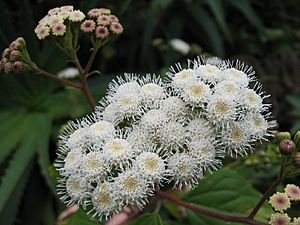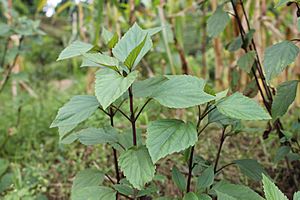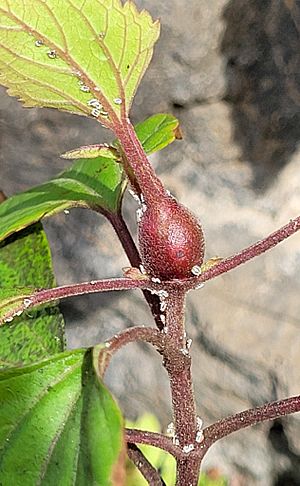Crofton weed facts for kids
Quick facts for kids Crofton weed |
|
|---|---|
 |
|
| Crofton weed | |
| Scientific classification | |
| Genus: |
Ageratina
|
| Species: |
adenophora
|
| Synonyms | |
|
|

Crofton weed, also known by its scientific name Ageratina adenophora, is a type of flowering plant. It comes from Mexico and Central America. People first grew it as a pretty garden plant. But now, it has spread to many parts of the world. It grows in farms and natural areas where it is not wanted. This plant is harmful to horses. If horses eat it, they can get a serious lung sickness.
Contents
What is Crofton Weed?
Crofton weed is known by several other common names. These include eupatory, sticky eupatorium, sticky snakeroot, thoroughwort, and Mexican devil.
How to Identify Crofton Weed
Crofton weed is a plant that grows back every year. It can grow quite tall, reaching about 1 to 2 meters (3 to 6 feet) high. Its leaves are shaped like a trowel and have jagged edges. They are usually 6 to 10 cm (2 to 4 inches) long.
The plant has small, creamy-white flowers. These flowers grow in bunches at the ends of its branches. You can see them in late spring and during the summer. Each flower head is about 0.5 cm across. After the flowers, small brown seeds appear. Each seed has a white, feathery "parachute." This helps the seeds float away in the wind, much like a dandelion seed.
Where Does Crofton Weed Grow?
Crofton weed is originally from Mexico. However, it has spread to many other places around the world. It is often considered a harmful or "noxious" weed.
Global Spread of Crofton Weed
This plant has caused big problems for farming in southwestern China. It was accidentally brought to Yunnan, China, around 1940. It spread quickly because it can stop other plants from growing nearby. This is called allelopathy.
Crofton weed also became a weed in Australia. It arrived in Sydney in 1904. From there, it spread along the coast of New South Wales and southern Queensland. In New South Wales, it is listed as a "Class 4 Noxious Weed."
It has also spread in Hawaii and parts of the United States. It is a known weed in ten states in the South and Southwest. Crofton weed is an invasive species in many tropical and subtropical countries. These include India, Sri Lanka, Nigeria, Southeast Asia, New Zealand, the Pacific Islands, the Canary Islands, and South Africa.
How Crofton Weed Spreads
This plant can spread in a few ways. Its stems can grow roots and new plants if they touch the ground. This is called vegetative spread. Its seeds are also carried by wind or water. They easily grow in disturbed areas, like fields or places near homes. Animals and soil can also carry the seeds to new locations.
Insect Galls on Crofton Weed
Crofton weed can be home to certain insects. One insect, the Procecidochares utilis (Eupatorium Gall Fly), causes bumps on the plant's stems. These bumps are called galls.
external link to gallformers
Why Crofton Weed is Harmful
Crofton weed is poisonous to farm animals, especially horses. If horses eat this plant often, they can get a long-term lung disease. This disease is known as Numinbah Horse Sickness. It is also called Tallebudgera Horse Disease in parts of Australia.
Outbreaks of this sickness happened in Hawaii in the 1920s. Later, they occurred in eastern Australia and New Zealand. Some farms have lost all their horses because of this plant. Horses with this disease have trouble working or exercising. Their lungs can become damaged, similar to emphysema in humans.
Meaning of the Name
The name Ageratina comes from a Greek word. It means 'un-aging'. This refers to how the plant's flowers keep their color for a long time. An ancient Greek doctor named Dioscorides used this name for different plants.
See also
 In Spanish: Ageratina adenophora para niños
In Spanish: Ageratina adenophora para niños


